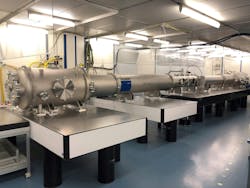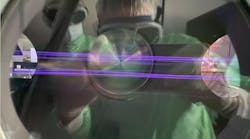XProLas, an ambitious initiative spearheaded by TRUMPF and funded by the German Federal Ministry of Education and Research (BMBF), is set to leverage the capabilities of laser-driven x-ray sources to revolutionize the process of developing electric car batteries. The project seeks to develop a compact, high-brilliance, next-generation laser-driven x-ray source and demonstration system that manufacturers can use to study and improve battery durability and performance.
The team envisions a mobile-home-sized device that enables manufacturers to conduct battery tests onsite, accelerating development and reducing costs. Currently, industry researchers must use hard-to-get time at a synchrotron facility to visualize the chemical process inside a battery to understand, for example, how repeated charge cycles affect the physical structure and reduce batteries’ capacity of the battery over time.
The development project aims to build the first demonstration systems by 2026.
An exclusive interview with Torsten Mans, TRUMPF’s product manager for secondary sources who leads the project, reveals insights into the project’s origins, the technical challenges necessary to overcome, and other applications that will benefit.
XProLas origins
Mans explained the effort started two years ago with a BMBF call for project proposals to explore developing high-radiation sources. To meet the goal, the effort would require solving several challenges outside TRUMPF’s expertise in delivering powerful lasers. “You need a suitable target, which will then emit x-ray radiation, and then the integrators, which take this extra radiation and do an application with it, and partners who deliver samples, where we can demonstrate the new measurement capabilities we are building,” he explained. So, he started talking with various companies TRUMPF could partner with. “Fortunately, we found companies willing and able to do this,” he said.
Within TRUMPF, the project grew from the company’s secondary sources initiative. Peter Leibinger, TRUMPF’s then chief technology officer and now TRUMPF supervisory board chairman, came up with this and pushed it for many years, Mans said. “The idea fit well with our secondary sources initiative we’d been pursuing,” he said.
“And the blueprint is the EUV [extreme ultraviolet radiation] technology” TRUMPF provides to ASML, the only company that produces and sells EUV systems for high-volume semiconductor manufacturing, Mans said. “We deliver the laser driver to produce this extreme ultraviolet light,” he explained. “And we call it the first commercially successful secondary source; it’s the core of this project.”
In laser technology, a secondary source refers to a device or component that generates secondary radiation or emission, such as light, x-rays, or electrons from an interaction with a primary laser beam.
In XProLas’ setup, a high-intensity laser beam will interact within a vacuum with a target material, typically a metal such as gallium, indium, or tin, creating a plasma that emits x-rays as part of its energy output.
As an aside, Mans explains that varying the target produces “different secondary radiation which has unique properties and can then be used to do something else.” For example, “You can also produce particle radiation,” he adds. “We have a running project to create laser-driven electrons.”
Technical challenges
To meet XProLas’ goals, the team must solve several scientific and technical challenges, according to Mans. A primary aim “is to create an x-ray source which has roughly an order of magnitude larger brightness compared to the state of the art,” he explained. X-rays are necessary for analyzing and determining the composition of the EV battery’s cathode material, which is critical to their performance and reliability. Mans added that synchrotrons, where such research is currently done, create the brightest radiation sources and develop new x-ray techniques, “but for real-world applications, the synchrotron is not suitable.”
The x-ray sources XProLas will develop will still generate significantly less brightness than what a synchrotron delivers, but will be “a factor of 10 more than what you can get to date [outside a synchrotron].”
Starting with advances in laser technology, “we need to create relativistic intensities to accelerate the electrons inside the target material, specifically that’s about 1018 watts per square centimeter or more,” Mans explained. “At the same time, we will do this at a kilowatt average power level, which has never been done before, so that’s a scientific challenge.”
To achieve this, TRUMPF plans to start with a kilowatt average power laser source with just under picosecond pulses, which are too long to generate the necessary relativistic intensities. “So, we will add a Herriott cell, a technique that broadens the spectrum and allows to create shorter pulse durations,” Mans said.
He added that using pulse lasers is a unique approach to creating the x-ray sources, and the team could run into issues with them and, possibly, the detectors as a result.
Another challenge is developing the targets, which, at relativistic intensities and a kilowatt average power, will immediately evaporate. “We’ll have a significant issue with debris, so you need to somehow shield your focusing optics and your windows to get the laser in and the x-ray out,” Mans explained. “And also, the beam positioning is quite an issue. You need to have a super stable surface of the liquid metal, which will be disturbed with a high average power laser with a 100 kHz pulse repetition rate.”
Also, developing new x-ray optics that can fully use the enhanced brightness is a technical challenge that arises for applications that use the extra radiation generated.
“So, on each bit of the chain, [there are] quite significant challenges, but I think it is a really good team and everyone is pretty confident that they can solve their part of the problem,” Mans concluded. “But it remains a high-risk research project.”
Beyond EV battery testing
While XProLas initially focuses on applications within battery production, its potential impact extends to other applications, including pharmaceutical companies requiring finer resolution in drug development and semiconductor manufacturers seeking to optimize production processes.
Also, by making compact x-ray sources available to manufacturers, the project will shift experiments traditionally confined to synchrotrons to individual company labs, where researchers could conduct in-depth analysis at a fraction of the size and cost and accelerate the pace of innovation.


